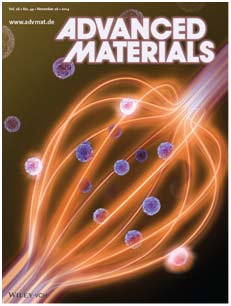Time:2014-11-22ClickTimes:

|
A nanofiber array for single nanoparticle
detection, shown on the front cover of
Advanced Materials, issue 44/2014.
|
Rapid detection and sizing of nanoscale particles become of increasing
importance in various fields, such as in early-stage biomedical diagnostics and
treatment, and in process control of semiconductor manufacturing, as well as in
explosives and environmental monitoring. Very recently, a group led by Prof.
Yun-Feng Xiao and Prof. Qihuang Gong from Peking University developed a
novelnanofiber sensor, and experimentally demonstrated its potential in
detection and sizing of single nanoparticles in an aqueous environment. This new
result was published in Advanced Materials (DOI: DOI: 10.1002/adma.201402085).
Optical fiber sensors have been extensively employed in high-sensitivity
biosensing, due to their advantages of simple configuration, low cost,
label-free property, and remote sensing capability. Over the past few years, it
has been demonstrated that when the diameter of fiber is reduced to the scale of
optical wavelength, there exists pronounced evanescent field outside the
nanofiber, which is very sensitive to the refractive index change of the
surrounding medium. In this work, the researchers fabricated a pair of
nanofibers with uniform diameter, and placed them into a microfluidic channel.
When single nanoparticlesin the microfluidic channel are bound to the surface of
the nanofibers, the transmitted power shows a significant decrease due to the
scattering and absorption of the nanoparticles in the evanescent field. By
monitoring the step changes in the transmission of the nanofiber, detection and
sizing of nanoparticles with single uniform radius (~ 100 nm) and of mixed
nanoparticles with two different radii (100 nm and 170 nm) are both realized.
Moreover, by employing plasmonic enhancement, detection of single gold nanorods
with much smaller sizes (diameter ~ 16 nm, length ~ 40 nm), is also
demonstrated. This nanofiber pair can be further extended to an array containing
more nanofibers, thus to dramatically increase the sensing speed, which promises
a bright future of the nanofiber sensors.
